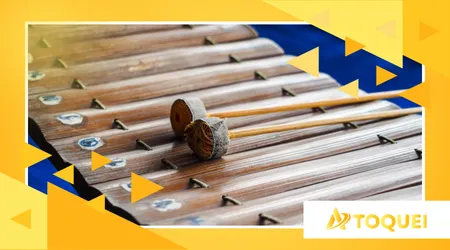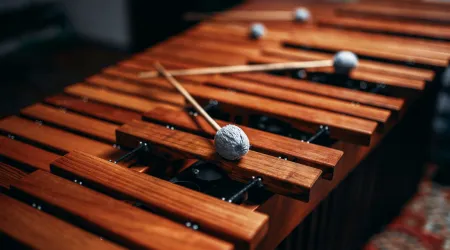What is balafon, the “African xylophone”?

What is Balafon, and why do we call it African xylophone? The Balafon, a melodic percussion instrument, resonates with the soul of West Africa.
Advertisements
It acts as a true cultural herald, telling centuries-old stories. Essentially, it's a type of xylophone with wooden slats arranged in a curved frame.
The nickname African xylophone is well deserved, given their remarkable structural similarity and function.
Its unique sound comes from the dried gourds placed underneath the keys, which act as natural resonators.
This ingenious construction provides a warm, earthy, and vibrant timbre. The name "Balafon" may derive from the Mandinka words "bala" (wood) and "fo" (to speak).
Advertisements
Therefore, the Balafon is the "speaking wood," a name loaded with meaning. To understand global musicality, ignoring the importance of this instrument is, at the very least, a disservice.
What is the Origin and History of This Fascinating Instrument?
The history of the Balafon is intrinsically linked to the Griot tradition of the Mandingo people. These guardians of West African history and genealogy used it in ceremonies.
The most famous legend tells the origin of Sosso-Bala, a sacred and mythical balafon.
This instrument was reportedly confiscated by Soumaoro Kanté, a tyrant king, and later recovered by the Griot Bala Faseke Kouyaté.
This event cemented the instrument as a symbol of power and cultural heritage. Sosso-Bala, today, is kept by the Kouyaté family in Niagassola, Guinea, and considered an invaluable treasure.
In 2008, the Balafon variant from the Sennoufo region of Mali was inscribed by UNESCO on the Representative List of the Intangible Cultural Heritage of Humanity.
This underlines the profound historical and social relevance of the African xylophone.
Read more: Bagpipes: history, types and curiosities
How is the Balafon Constructed and What Elements Create Its Unique Sound?
The construction of the Balafon is a testament to African inventiveness and craftsmanship. The blades are generally made of African rosewood (rosewood), or other local woods.
They are carefully carved and tuned to produce the desired musical notes. The main structural difference lies in the gourds attached under each blade.
Each gourd has a specific size, calculated to resonate with the frequency of the corresponding blade.
In many cultures, small holes in gourds are covered with thin membranes of spider web or cigarette paper.
This material, called mirliton, adds a characteristic “buzzing” vibration to the sound. Such details define the unmistakable timbre of this African xylophone traditional.
A practical example of its construction is its tuning. A 12- to 18-note balafon, common in Burkina Faso, can be tuned pentatonic or heptatonic.

The choice of wood and the precision of the gourd define the tonal quality of the instrument.
| Balafon Regions and Variations | Main Features | Common Tuning |
| Mandinga (Guinea, Mali) | Generally larger, lower tone (grave), ceremonial and Griot use. | Heptatonic (7 notes) |
| Senoufo (Burkina Faso, Ivory Coast) | Focused on orchestras, often pentatonic. | Pentatonic (5 notes) |
| Balafon-Jazz (Modern) | Adaptation with Western tempered tuning and use in jazz ensembles. | Diatonic or Chromatic |
What is the Cultural Impact and Social Function of Balafon?
The Balafon transcends the simple category of musical instrument; it is a social and ritual mediator. Balafon music accompanies a wide range of events in community life.
++ What is a dulcimer and where is it still used?
From funerals to weddings, harvest festivals, and initiation rituals, the balafon player, often a griot, acts as a chronicler and advisor.
Its performance can evoke ancestral spirits, celebrate heroes of the past, or simply enliven a dance. Oral tradition is inseparable from this instrument.
As an analogy, think of the Balafon as a community's news bulletin and almanac, all condensed into melody. It is the sonic memory of a people.
Why is Balafon Still Relevant in the 2025 Music Scene?
In 2025, Balafon is far from being a museum piece; it lives and breathes in contemporary music.
Its peculiar and complex sound captivated musicians from world music and of jazz avant-garde. Artists such as Kélétigui Diabaté (Mali) and more recently, artists from fusion global, use Balafon.
The instrument offers a timbral color not found in Western equivalents.
Its relevance lies in the authenticity and rhythmic richness it injects into any production. African xylophone offers a sonic bridge between the ancestral and the modern.
Its unique sound has been sampled in electronic productions, showcasing its versatility. Can we truly talk about musical diversity without recognizing the power of this African instrument?
An example of its contemporary presence is Afro-jazz music.
Musicians are integrating the Balafon with drums and electric basses, creating a fascinating dialogue. This proves that African xylophone is perfectly adapted to the new times.
++ Discovering the Rebab: An Ancient Chordophone Present in Many Cultures
Is There Any Updated Data on the Global Impact of Balafon?
Yes, Balafon enjoys growing global attention in the field of ethnomusicology and popular music.
A recent UNESCO study (2023) on the Intangible Heritage of West Africa highlighted the importance of its preservation.
This study points out that the number of festivals and workshops dedicated to Balafon in Europe and the Americas increased by 35% in the last five years.
This demonstrates a clear interest in learning and celebrating the culture behind this instrument.
Another relevant statistic points out: Around 60% of musicians world music contemporary African music on Spotify, which has more than 100,000 monthly listeners, uses Balafon on at least one track.
This demonstrates its insertion and popularity in the digital scene. African xylophone is winning over new audiences.
++ African xylophone with wooden keys, played with drumsticks – *you will leave this blog*
Conclusion: The Unmistakable Voice of the African Xylophone
The Balafon, more than an instrument, is a cultural legacy in the form of sound. Its history, intrinsically linked to the Griots, gives it a rare depth.
The beauty of its construction, from the wood carving to the resonating gourds, is a feat of popular engineering.
THE African xylophone continues to inspire, evolve and captivate listeners around the planet.
Its permanence on the music scene is proof that the richest traditions are those that adapt without losing their essence.
Frequently Asked Questions
Is the Balafon the same as the Marimba?
Not exactly, although they are both struck idiophones and share the idea of wooden blades.
The Marimba, developed in America, generally has a longer range and wider keys, and its soundboards are often made of wood or metal, not gourds.
What are the main countries where Balafon is traditional?
Balafon is most prominent in West Africa. Countries such as Mali, Guinea, Burkina Faso, Ghana, Ivory Coast, and Senegal are considered its cultural heartland.
How is the Balafon tuned?
Traditional tuning is complex and based on scales that are not Western tempered, such as the pentatonic (5 notes) or heptatonic (7 notes) scales specific to the Mandinga or Senoufo region.
Tuning is done by scraping the underside of the wooden blade.
